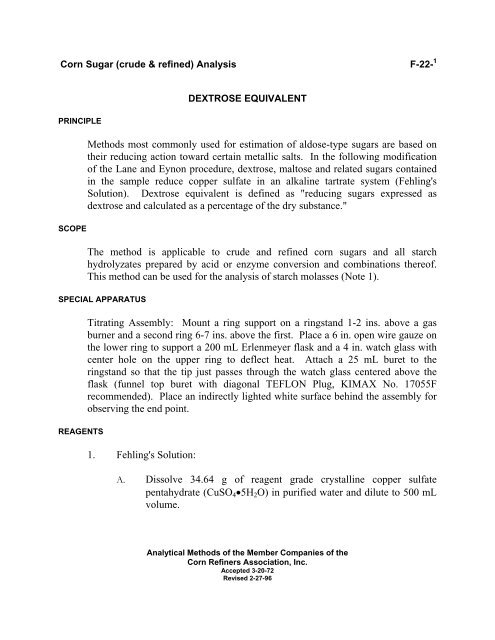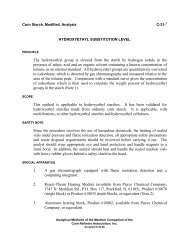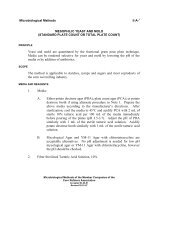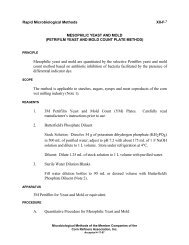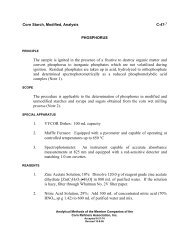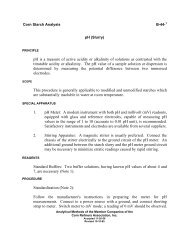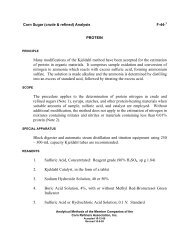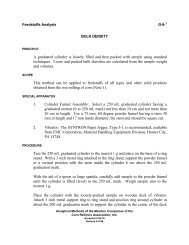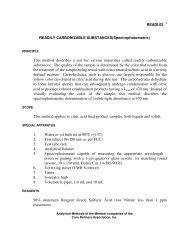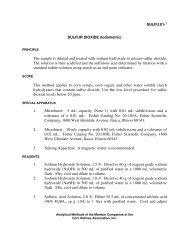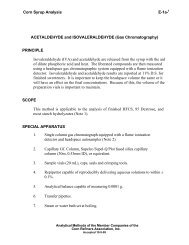Methods most commonly used for estimation of aldose-type sugars ...
Methods most commonly used for estimation of aldose-type sugars ...
Methods most commonly used for estimation of aldose-type sugars ...
You also want an ePaper? Increase the reach of your titles
YUMPU automatically turns print PDFs into web optimized ePapers that Google loves.
Corn Sugar (crude & refined) Analysis F-22- 1PRINCIPLESCOPEDEXTROSE EQUIVALENT<strong>Methods</strong> <strong>most</strong> <strong>commonly</strong> <strong>used</strong> <strong>for</strong> <strong>estimation</strong> <strong>of</strong> <strong>aldose</strong>-<strong>type</strong> <strong>sugars</strong> are based ontheir reducing action toward certain metallic salts. In the following modification<strong>of</strong> the Lane and Eynon procedure, dextrose, maltose and related <strong>sugars</strong> containedin the sample reduce copper sulfate in an alkaline tartrate system (Fehling'sSolution). Dextrose equivalent is defined as "reducing <strong>sugars</strong> expressed asdextrose and calculated as a percentage <strong>of</strong> the dry substance."The method is applicable to crude and refined corn <strong>sugars</strong> and all starchhydrolyzates prepared by acid or enzyme conversion and combinations there<strong>of</strong>.This method can be <strong>used</strong> <strong>for</strong> the analysis <strong>of</strong> starch molasses (Note 1).SPECIAL APPARATUSREAGENTSTitrating Assembly: Mount a ring support on a ringstand 1-2 ins. above a gasburner and a second ring 6-7 ins. above the first. Place a 6 in. open wire gauze onthe lower ring to support a 200 mL Erlenmeyer flask and a 4 in. watch glass withcenter hole on the upper ring to deflect heat. Attach a 25 mL buret to theringstand so that the tip just passes through the watch glass centered above theflask (funnel top buret with diagonal TEFLON Plug, KIMAX No. 17055Frecommended). Place an indirectly lighted white surface behind the assembly <strong>for</strong>observing the end point.1. Fehling's Solution:A. Dissolve 34.64 g <strong>of</strong> reagent grade crystalline copper sulfatepentahydrate (CuSO 4 •5H 2 O) in purified water and dilute to 500 mLvolume.Analytical <strong>Methods</strong> <strong>of</strong> the Member Companies <strong>of</strong> theCorn Refiners Association, Inc.Accepted 3-20-72Revised 2-27-96
Corn Sugar (crude & refined) Analysis F-22- 2DEXTROSE EQUIVALENT ⎯ continuedPROCEDUREB. Dissolve 173 g <strong>of</strong> reagent grade potassium sodium tartratetetrahydrate (KnaC 4 H 4 O 6 •4H 2 O) and 50 g <strong>of</strong> reagent grade sodiumhydroxide (NaOH) in purified water and dilute to 500 mL volume.Measure a quantity <strong>of</strong> Solution A, add an equal quantity <strong>of</strong> SolutionB, and mix (Note 2). Standardize as follows, immediately prior touse:Dry a quantity <strong>of</strong> National Institute <strong>of</strong> Standards and Technology(NIST) dextrose in a vacuum oven at 70 °C <strong>for</strong> 4 hrs. Dissolve3.000 g in purified water, dilute to 500 mL volume and mixthoroughly. Pipet 25.0 mL <strong>of</strong> mixed Fehling's Solution into a 200mL Erlenmeyer flask that contains a few glass beads, and titrate withthe standard dextrose solution as directed under procedure. Adjustconcentration <strong>of</strong> Fehling's Solution A by dilution or addition <strong>of</strong>copper sulfate so that the titration requires 20.0 mL <strong>of</strong> the 0.6%standard dextrose solution.2. Methylene Blue Indicator: 1% aqueous solutionWeigh accurately an amount <strong>of</strong> sample such that after dilution the solutioncontains about 0.6% reducing <strong>sugars</strong> (Note 3). Transfer the sample quantitativelyto a 500 mL volumetric flask with the aid <strong>of</strong> hot water, cool to room temperature,dilute to volume and mix thoroughly.Pipet 25.0 mL <strong>of</strong> standardized mixed Fehling's Solution into a 200 mL Erlenmeyerflask and add a few glass beads. Add the sample solution by means <strong>of</strong> the buret towithin 0.5 mL <strong>of</strong> the anticipated end point (determined by preliminary titration).Immediately place the flask on the wire gauze <strong>of</strong> the titration assembly, and adjustthe burner so that the boiling point will be reached in about 2 mins. Bring to boiland boil gently <strong>for</strong> 2 mins. As boiling continues, add 2 drops <strong>of</strong> methylene blueindicator and complete the titration within 1 min. by adding sample solutiondropwise or in small increments until the blue color disappears (Note 4).Determine the dry substance concentration <strong>of</strong> the sample by an approvedprocedure.
Corn Sugar (crude & refined) Analysis F-22- 3DEXTROSE EQUIVALENT ⎯ continuedCALCULATION% Reducing Sugars (as is, calc.as dextrose)=(500 mL)(0.1200)(100)(Sample Titer, mL)(Sample Wt., g)Dextrose Equivalent=(% Reducing Sugars )(100)% Dry SubstanceNOTES AND PRECAUTIONS1. The Association <strong>of</strong> American Feed Control Officials defines starchmolasses as "the by-product <strong>of</strong> the manufacture <strong>of</strong> dextrose from starchderived from corn or grain sorghums in which the starch is hydrolyzed byuse <strong>of</strong> enzymes and/or acid."2. Fehling's Solution in mixed <strong>for</strong>m is relatively unstable but may be retainedup to 1 week if standardization is confirmed be<strong>for</strong>e using.3. In the analysis <strong>of</strong> refined <strong>sugars</strong>, use 3 g <strong>of</strong> sample dry substance. For othersample <strong>type</strong>s, including starch molasses, calculate approximate sampleweight using the following <strong>for</strong>mula:Sample Weight=(3 g)(100)(100)(Anticipated D.E.)(% Dry Substance)Concentration should be such that sample titer is near 20 mL, but shouldnot exceed limits <strong>of</strong> 15 and 25 mL. Inter- and intralaboratory precision isimproved by adjusting all sample concentrations to provide titers between19 and 21 mL.4. When approaching the end point, allow about 5 secs. reaction time betweenadditions <strong>of</strong> sample solution.


